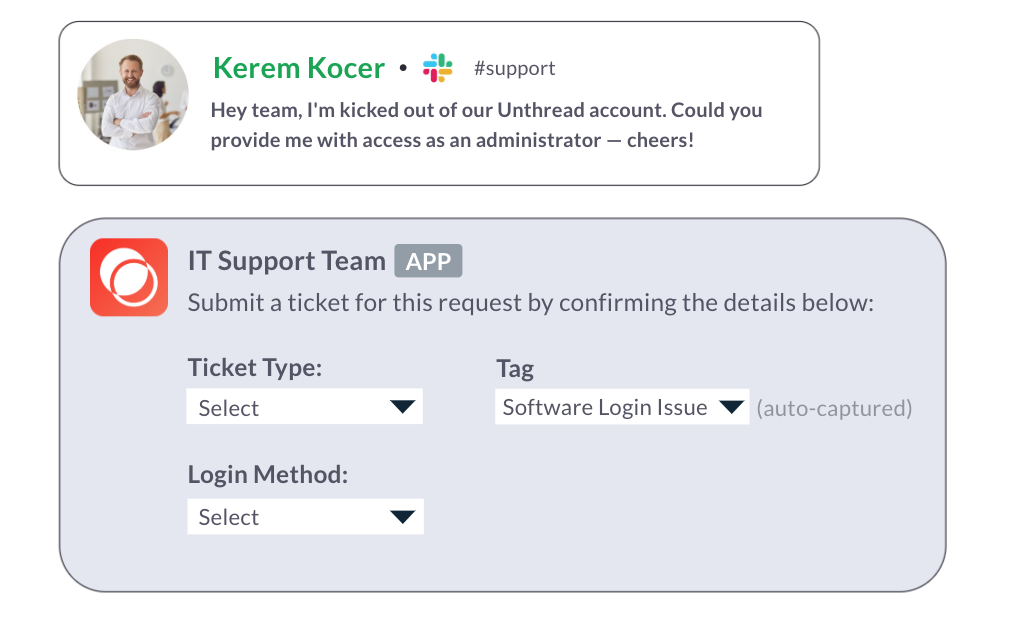What is IT Self-Service?

IT self-service is an approach where end-users can resolve common IT issues and submit service requests without relying on the IT support team for every minor problem. IT self-service systems offer features like self-service portals, knowledge bases, and automated solutions, allowing users to find answers and resolve issues independently — without waiting for a human help desk representative. Recently, the self-service space has been redefined with the rise of AI technology. With the AI agents, resolving an ad hoc ticket is becoming more convenient. By adopting these solutions through working with innovative vendors, companies can significantly reduce the time and resources spent on repetitive IT tasks, leading to more efficient support service delivery.
For large enterprises, the adoption of IT self-service began in the early 2000s with basic workflows. Now, AI-native platforms like Unthread are driving the next wave of innovation in IT automation, offering smarter, faster, and more effective solutions.

Why Do So Many Companies Prefer Self-Service?
IT self-service benefits both end-users and IT teams. As IT environments grow in complexity, IT teams are increasingly stretched thin and prefer not to be interrupted by minor support requests. An IT self-service portal allows them to focus on more critical tasks, improving the department's value.
For end-users, the frustration of waiting for email or Slack responses from IT is all too familiar. When a quick solution is needed, the service offerings of traditional help desks often struggle to meet those expectations, especially when reliant on legacy software that requires multiple steps to route tickets to the correct human representative. In contrast, self-service agent solutions enable immediate resolution of common issues, significantly improving user satisfaction and streamlining the support experience. Beyond improving internal support operations, self-service platforms also reduce operational costs and create leaner, more efficient IT service models.
What Are the Advantages of Using Self-Service?
The adoption of IT self-service solutions provides several key advantages, particularly for enterprises looking to streamline their IT services:
- Reduction in IT Tickets: Self-service tools significantly reduce the number of IT support tickets resolved by human agents by automating routine tasks and allowing users to resolve issues independently. With resources like a comprehensive knowledge base, companies can drastically reduce the burden of service desk issues on IT teams, enabling them to focus more on complex and high-priority problems.
- Increased Efficiency: A self-service portal simplifies issue resolution. With features like a service catalog, users can submit requests for new services or troubleshoot problems independently. This boosts the overall efficiency of IT service management, especially in organizations with large user bases, improving both incident and request management workflows.
- Better Customer Experience: A well-designed service portal improves the customer service experience by providing quick and reliable access to IT services. AI chatbots and machine learning algorithms can proactively suggest solutions, improving user satisfaction. For enterprises, maintaining a consistent and high-quality customer experience is vital to ensuring employee productivity and satisfaction.
- Enhanced Compliance and Security: Self-service platforms also help organizations maintain compliance with data security regulations. By using automation and integrated workflows, companies can ensure that IT policies are consistently enforced, reducing the risk of non-compliance while handling larger requests.
How Does Self-Service Systems Work?
IT self-service platforms centralize support resources into a single interface, allowing users to resolve issues, access information, and request new services without a request's progress and ensure timely resolution. For enterprises, IT intervention. Here’s how these systems typically operate in enterprise environments:
Service Requests
Users can submit service requests through a service portal, where they can describe their issue and select from a list of available service options. For enterprises, these requests can be prioritized based on urgency, ensuring critical business functions are supported first.
Knowledge Base
A well-designed internal knowledge base plays a crucial role in self-service. For the algorithm to find the information, that information has to exist somewhere in the system so that users can find solutions independently. It relies on effective content management, ensuring articles are well-organized, updated, and easy to find. Natural language search capabilities improve accuracy by interpreting user intent, making it easier to locate relevant information.
AI-powered virtual agents utilize the knowledge base as a tool, providing real-time, automated responses to user queries by referencing its content. This reduces the need for human intervention while ensuring consistent support. Analytics and feedback help continuously refine the knowledge base, while security features ensure proper access control, maintaining compliance and content integrity.

AI and Automation
Enterprises can leverage artificial intelligence and automation to handle large volumes of requests and improve service delivery. AI-powered chatbots offer real-time assistance, helping IT teams manage high ticket volumes without sacrificing the quality of service.
Reporting and Resolution
IT self-service platforms provide features for reporting and resolving IT incidents. They offer tracking tools to monitor a request's progress and ensure timely resolution. For enterprises, detailed reporting on incident response times and resolution metrics is crucial for maintaining efficient and accountable IT operations.
Using a self-service platform, enterprises can reduce IT tickets by up to 70%, allowing IT teams to focus on more strategic initiatives and higher-level incidents.
What differentiates Unthread's Self-Service for internal IT support:
Nowadays, enterprises are looking for AI agents more than anything. They are interested in minimizing human interaction for IT teams and only involve them for more complex tickets. Unthread's Slack-native ticketing system for IT support makes this possible by providing a unified view with personalized workflows to automate the self-service experience. Unthread users can access information and complete internal tickets without the hassle of waiting on IT support.
Unthread's IT self-service option provides a centralized platform for accessing a wide range of support services. It automatically tracks incoming tickets from Slack threads and uses AI to categorize, escalate, and run workflows to solve issues before they reach a human agent.

Conclusion
Incorporating IT self-service tools into your enterprise offers clear benefits, including significant cost reductions, improved user experience, and enhanced operational efficiency. With features like a comprehensive service catalog, AI-powered chatbots, and a well-maintained knowledge base, IT self-service platforms end users the burden on IT teams.
Unthread's self-service solution offers the scalability, reliability, and integrated support enterprises need to thrive.

